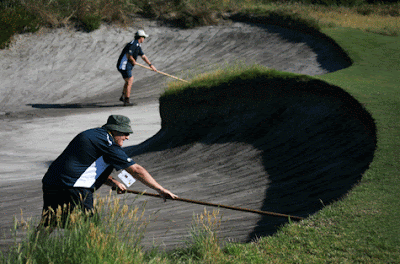Over the past few months I have been trialing a few different types of fairway mowers to repl ace our existing units and the decision has been made and they are now ordered. I have selected the Toro 7000 series machines and am looking forward to them arriving in the next week or so. The 7000 is a new series of fairway mower and we will be the first to get them in Australia
At the same time as the fairway mowers we will also take delivery of a new intermediate rough mower. This mower is a rotary type and will be totally different from our existing unit which is a reel mower. One of the main advantages of the rotary type is its ability to mow seed head and mulch leaves. The new intermediate mower will also help with the fairway de-lineation.
Our existing fairway mowers have served us well for nearly 3,000 hours operation time and the intermediate mower with 3,700 hours but are now having frequent minor issues. In the world of golf course mowers, 2,000 hours is considered to be the equivalent of 100,000 klms on a car which is often when little things start going wrong so considering their hours they have performed very well.
And just on machine hours, our roughcutters have all now passed the 2,000 hour mark. The mowers are scheduled for repl acement this time next year and will probably have at least 3,000 hours on the clock by then. This means that we will probably start to have some issues with them in the coming months as the wear and tear they suffer on a daily basis takes its toll. This is not the greatest situation when we are heading into the main growth season but I am sure we will get through. With regards to rough mowing, we never actually “finish” cutting rough, especially in the growth season. It takes about six days for the three machines to mow all the rough areas on the courses with no time lost. The new intermediate mower should help by also being used to mow some rough areas although it will have a canopy fitted to ensure it isn’t taken under trees which is where severe damage can result to the cutting heads.
Last Thursdays rainfall whilst most welcome on the golf courses meant the postponement of the tree trimming over the practice nets which has now been re-scheduled for Thursday December 1st. These works will require the nets to be closed to all pl ay to ensure both pl ayer and contractor safety. There will also be some buggy detours in pl ace around the clubhouse.
I have had some comments about the number of leaves on fairways and in bunkers recently. Unfortunately this is the time of year for the courses to be messy, especially with the constant winds which have now been blowing from the north consistently virtually 24/7 for the past six weeks. The wind coupl ed with the dry conditions we have been experiencing causes the trees to shed their bark and the trees also shed their weaker leaves. Many of the bunkers on the courses are virtually “leaf collectors” and are full of leaves within an hour of being blown clean. We do have a dedicated “mulching” mower which operates virtually non stop in periods such as these and we also have a sweeper as well but it is very slow and needs constant emptying. I did a trial with it a few years ago and found that it took nearly 2½ hours to sweep the 4th River fairway when it was covered with leaf litter. The mulcher on the other hand can clean the same fairway in less than 20 minutes. The rough areas are also full of leaves which makes finding balls difficult but we just can’t keep up with mowing / mulching them at this time of year.
On Thursday December 1st we will be topping up the sand in a few bunkers on the courses. This sand has been used with apparent success at a number of south east Queensland
The fan at the 17th West green will also be re-installed on December 1st....A busy day with only 13 crew onsite!
The fan at the 17th West green will also be re-installed on December 1st....A busy day with only 13 crew onsite!









